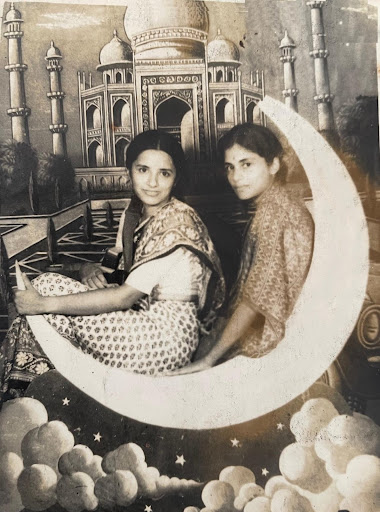In March 2022, my friend Chandita Mukherjee sent me this photograph taken 45 years ago. Two bright-eyed young women in their twenties, sitting on the edge of a crescent moon, gaze upon the viewer, a slight smile on their faces. The Taj Mahal in the background and some clouds in the foreground complete the photograph. She wrote:
Look at what I found while cleaning up an old drawer. Can you imagine yourself and myself at this age? We are around 26 and 23 here.
When was this taken? I remember that we had gone to a fun fair and posed before an old box camera for a souvenir. But where, in Cross Maidan, Bombay or in Nagpur on our Kamptee trip? 1978 or 79?
Influence of Georges Méliès’ fantasy of space travel plus the romance of the Taj Mahal. The photographer exposed the image directly on photo paper inside the box and developed the print then and there in minutes.
How simple and inexperienced these girls look! And here we are, four and half decades later…
The photograph evoked a train of memories and I replied:
How lovely to hear from you and to revisit what we were like 45 years ago! This photo was taken near the Mahim dargah, at the annual Urs Mela, probably in 1978. I remember the experience very clearly as if it were yesterday. We had to suppress our giggles as we posed for it, with dreamy expressions! Thanks very much for sharing it with us.
What a different world we lived in then, when hope came easily and we were convinced that we could make the world a better place!
A year later and my friend is no more with us, taken swiftly and cruelly by metastatic cancer. She no longer exists in material form, but for me this picture is tangible and palpable, an entry into myriad memories of times spent together, times that transformed me from a timid and shy girl into a person who enjoys working with people, images and creative narratives.
Sontag speaks of photography as an act of appropriating the world. In this context, what does it mean to pose before the camera, setting up this image of ourselves? This photo, taken decades before the selfie, part tongue-in-cheek, part celebrating our friendship that took us to unexpected places, is for me an act of affirmation of our presence in this world. Its other-worldly quality is offset by the presence of two young women, filled with wanderlust and joie de vivre, wanting the moon and more. Never mind that the world changed unrecognisably in the years that followed, making belief in a better tomorrow difficult. Never mind that we grew older, our hair greyer.
I am reminded of the documentary film City of Photos by Nishtha Jain, that so beautifully explores how people fashion their own images, in collaboration with studio photographers, using digital artefacts to curate relationships and experiences that will last beyond their times. This was of course in pre-selfie days, when images were not as ubiquitous as they are today. Our image predates even those times, analogue and with limited possibilities for enactment. I remember that we had a choice between a red car and the Taj Mahal plus the moon as a set. The moon was more appealing and magical.

To me, this photograph is a metaphor for years of friendship and joyful camaraderie, but also with the presentiment of loss, disappointment and transience, that are a part of the human condition. The unchanging materiality of the image in an age where all has changed is both evidentiary and unreal, as unreal as the two of us sitting on the crescent moon in front of the Taj. The image idealises, it makes us screen out and forget the difficult moments, the blood, sweat and tears that are a part of everyday life. The image freezes time and space in its immediacy, in its invitation to witness a unique moment, that is ours alone, that will never be again. Gazing upon this image, with the knowledge that my friend has gone forever, fills me with a sense of her presence, as well as her absence. The deep pain of loss is tempered by memories of being footloose and fancy-free together, as we created media that we thought could bring about change. The adventures we had together are alive in my memory and this image evokes all of them, along with the ethos of a different age.
Cut to 38 years later, to a selfie of us, taken on a road trip to Hampi and Badami on August 15, 2016. I remember the moment sharply. We were lying on the cold stone floor of one of the ruins in Hampi, resting our aching backs and legs. And a photo seemed like a good idea.

How different it is from our image of the 1970s. A testimony to changes in technology and image-making aesthetics. Our smiles wide and our faces happy, it is a spontaneous moment, documented for posterity. Yet both are similar in terms of the mood they evoke, the joy of two women having a lovely time together.
Everything passes, everything changes. For now, these photographs are for me a source of comfort, a means to come to terms with loss and grief. But even when both of us are no more, these images will remain as testimony. They will be seen by eyes that interpret them differently. That is the nature of images, their openness to interpretation even as they aspire to capture a slice of our world. Photographs capture moments in time but they also reveal its continuities. There will be no more new photos of us, of time shared together, but in this moment, we are enjoying a monument in Hampi, as much as we are posing in front of the Taj Mahal on the edge of the moon.



